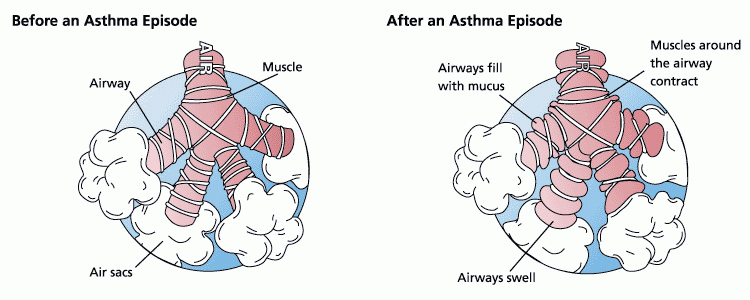|
|
| Line 4: |
Line 4: |
|
| |
|
| == Pathophysiology == | | == Pathophysiology == |
| Wheezes occupy different portions of the [[respiration (physiology)|respiratory]] cycle depending on the site of airway obstruction and its nature. The proportion of the respiratory cycle occupied by the wheeze roughly corresponds to the degree of airway obstruction.{{rf|1|Baughman}}<sup>,</sup>{{rf|2|Pasterkamp}} [[Bronchiole|Bronchiolar]] disease usually causes wheezing that occurs in the expiratory phase of respiration. The presence of expiratory phase wheezing signifies that the patient's [[Spirometry|peak expiratory flow rate]] is less than 50% of normal.{{rf|3|Shim}} Wheezing heard in the inspiratory phase on the other hand is often a sign of a stiff stenosis, usually caused by [[tumor]]s, foreign bodies or scarring. This is especially true if the wheeze is monotonal, occurs throughout the inspiratory phase (ie. is "holoinspiratory"), and is heard more [[Anatomical position|distally]], in the [[Vertebrate trachea|trachea]]. Inspiratory wheezing also occurs in hypersensitivity pneumonitis.{{rf|4|Earis}} Wheezes heard at the end of both expiratory and inspiratory phases usually signify the periodic opening of deflated [[pulmonary alveolus|alveoli]], as occurs in some diseases that lead to collapse of parts of the [[lung]]s.
| |
|
| |
|
| The location of the wheeze can also be an important clue to the diagnosis. Diffuse processes that affect most parts of the lungs are more likely to produce wheezing that may be heard throughout the [[chest]] via a stethoscope. Localized processes, such as the occlusion of a portion of the respiratory tree, are more likely to produce wheezing at that location, whence the sound will be loudest and radiate outwardly. The pitch of a wheeze does not reliably predict the degree of narrowing in the affected airway.{{rf|5|Meslier}}
| |
|
| |
| Wheezing can also occur in people who are deconditioned.
| |
|
| |
|
| [[Image:Asthma before-after.png|thumb|center|500px|'''Inflamed airways and bronchoconstriction in asthma'''. Airways narrowed as a result of the inflammatory response cause wheezing.]] | | [[Image:Asthma before-after.png|thumb|center|500px|'''Inflamed airways and bronchoconstriction in asthma'''. Airways narrowed as a result of the inflammatory response cause wheezing.]] |
Revision as of 19:17, 24 April 2013
